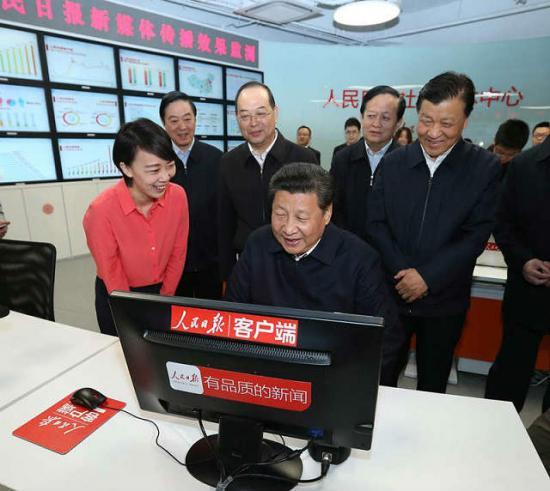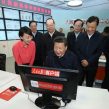
In a Fortnight: Xi Jinping Exhorts Media to Follow the Party’s Guidance; Sino-U.S. Competition for Influence in Southeast Asia Intensifies
Publication: China Brief Volume: 16 Issue: 4
By:

China’s turn inward and focus on domestic security and political control are frequently documented in these pages. The past two weeks have seen additional evidence of the increasing power and authority of the Chinese Communist Party (CCP) and its General Secretary, Xi Jinping. A second noteworthy set of developments concerns China’s diplomacy in Southeast Asia, where China’s competition with the United States for influence in Southeast Asia is intensifying.
Xi Jinping Exhorts Media to Follow the Party’s Guidance
Xi has recently visited a number of State media organizations, including the offices of People’s Daily, the Xinhua News Agency, and China Central Television (CCTV, February 20). In a similar visit in late December of this past year, Xi visited the PLA Daily, the official publication of China’s military produced by the PLA’s General Political Department (China Military Online, December 26, 2015).
As explained in a series of “study notes” for CCP cadres on the website of the CCP’s magazine, Seeking Truth, Xi’s speeches during his recent visits are part of his larger arc of thought on “Propaganda Thought Work” (宣传思想工作), which includes a speech on the topic in 2013 and the well-known Talk at the Forum on Literature and the Arts in 2014 (Qiushi Online, February 23; Xinhua, August 20, 2013; China Brief, November 2, 2015). Core themes that emerge from the “study notes” are: correct representation of trends—China’s rise and development and promotion of loyalty to the Party, the latter a key part of Xi’s December visit to the offices of the PLA Daily. Guiding public opinion is an explicit responsibility of media across traditional and new media.
Despite the proliferation of social and “new” media, in China, traditional media, including television remains a vital part of the state’s ability to affect public opinion. As Andrew Chubb has reported, 90 percent of Chinese citizens still receive their news on important foreign policy topics such as maritime disputes from television, making Xi’s visits to media offices more than a photo-opportunity; they represent direct, top-level outreach to important propaganda tools. [1]
Social media, once touted as a breakthrough technology in China that would diminish the influence of State media, has instead seen a recent decline, even as the numbers of China’s Internet users continue to surge. This is due in part to the fact that the various platforms have not become the predicted vibrant arenas for political discussion. Weibo, a Chinese clone of Twitter, for example, has seen many of its initially vocal and prolific users cease using the service all together, due in part, to aggressive censorship and registration requirements that include personal identification numbers (China Brief, February 7, 2014). Many users whose content includes certain keywords find themselves made invisible to others on the service, censored without the heavy-handed denial of service that has forced many of China’s netizens to use Virtual Private Networks (VPNs) to access international media (China Brief, January 23, 2015).
Xi Jinping has close connections with several officials within the Chinese media establishment, making, for example the Deputy Chief of the CCP’s Propaganda Department, Lu Wei, his top official for Internet policy (China Brief, April 16, 2015). Lu Wei’s role in Internet regulation is an integral part of his propaganda role, rather than a separate position. As mentioned in Xi’s speech in 2014 to the Small Leading Group on Deeping Reform, traditional and “new” media must develop together and “strengthen Internet thought” (强化互联网思维).
Within a country that already closely polices its media, these exhortations—particularly from the pinnacle of Chinese authority—represent an attempt to ensure that an even narrower set of views (read, Xi’s) are represented, even within the broader CCP.
Less clear is how elite politics plays into this area that Xi himself has clearly made a priority. The Propaganda Department’s head, Liu Yunshan, is commonly viewed as one of Xi’s rivals, with ties to former President Jiang Zemin. Xi’s personal visits to the PLA Daily, People’s Daily, Xinhua News Agency and CCTV, therefore, could be viewed as a way of negating Liu’s influence.
Sino-U.S. Competition for Influence in Southeast Asia
In mid-February United States President Barack Obama convened a meeting of ASEAN leaders, minus China, at the Sunnylands ranch, where he hosted Chinese President Xi Jinping last fall. China has remained active in the region, with Xi Jinping visiting several countries in the region last November (China Brief, November 16, 2015). Several Southeast Asian nations have mixed feelings about the U.S.’s influence in the region, and China has successfully courted Thailand’s ruling military government. China has made a point of actively showing the flag in the region, with the People’s Liberation Army conducting a series of port calls in Thailand and Bangladesh (People’s Daily Online, January 28; People’s Daily Online, February 17).
Other states in Southeast Asia that have been wary of Chinese territorial claims and influence are experiencing leadership turnovers that bode well for China. China-Myanmar relations are likely to deepen, despite frequent predictions of a strong Westward turn after Myanmar’s democratic elections (See Chinese Influence Faces Uncertain Future in Myanmar in this issue). The recent re-election of conservative Nguyễn Phú Trọng as General Secretary of the Vietnamese Communist Party is likely to mean that CCP-VCP relations, always the strongest aspect of the China-Vietnam relationship, continue (People’s Daily Online, January 27; BBC Chinese, January 27). Hardline Philippine President Benigno Aquino III, who has helped advance his country’s territorial dispute with China in the South China Sea in international arbitration proceedings will step aside later this year as the Philippines hold presidential elections. Several of the frontrunners are believed to be committed to rebuilding the Philippines’ relationship with China, or have announced opposition to U.S. bases there (Rappler, February 5, 2015).
With the upcoming U.S. presidential election in 2016, maintaining a consistent set of policies and engagement, other than regularly scheduled military exercises, will be difficult, contributing to doubts about U.S. commitment to the region. China will continue to push back, diplomatically, and through shows of force, such as the much-discussed deployment of HQ-9 Surface-to-Air missiles to Woody Island (永兴岛), which was likely, in part, meant to help strengthen China’s diplomatic position when Foreign Minister Wang Yi visits the United States at the end of February (MFA, February 23; Pengpai, February 23).
Note
1. Andrew Chubb, “Exploring China’s ‘Maritime Consciousness’ Public Opinion on the South and East China Sea Disputes,” Perth USAsia Centre, 2014, https://perthusasia.edu.au/usac/assets/media/docs/publications/2014_Exploring_Chinas_Maritime_Consciousness_Final.pdf.





